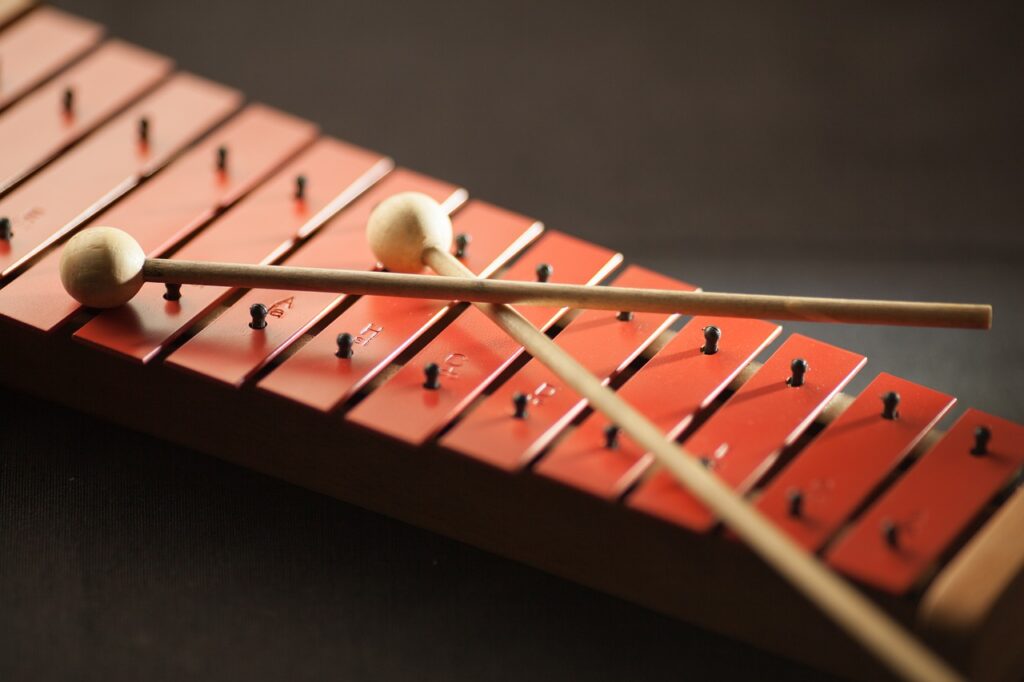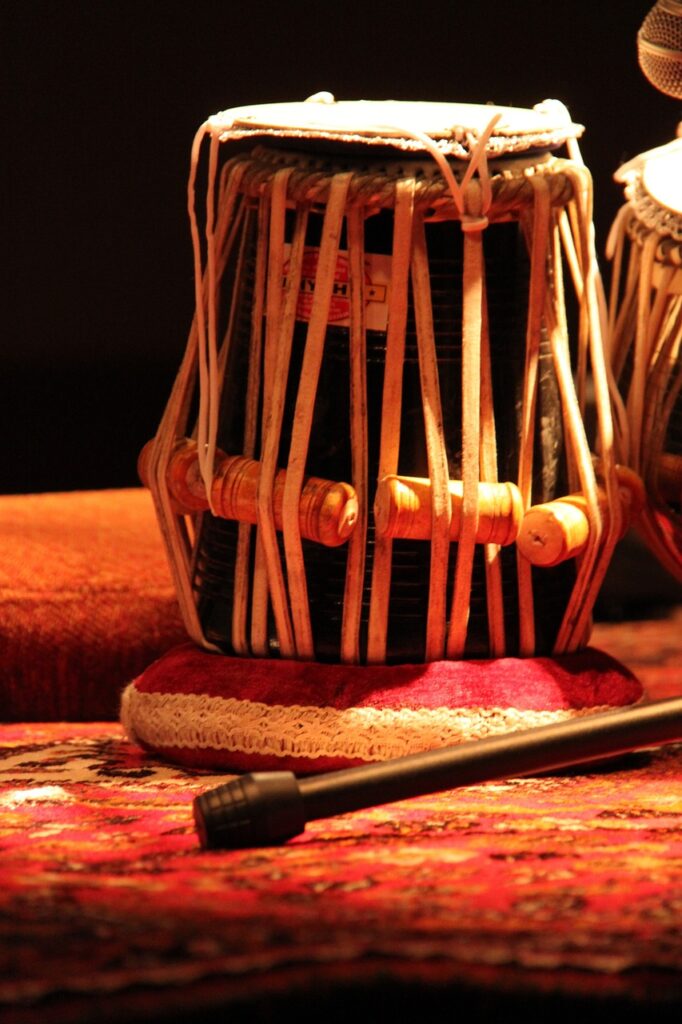
Kathak is an Indian classical dance form that originated in the temples of North India. The Music in Kathak Dance is an integral part of Kathak and it plays a vital role in the rhythm of the performance.
The music used in Kathak dance is typically Hindustani Classical Music. This type of music is based on the raga, tala, or rhythmic cycle, that Kathak dancers need to synchronize their movements with the tala, creating a beautiful and mesmerizing interplay of sound and movement. The seamless integration of music and dance is what makes Kathak a truly captivating and holistic art form.
The Musical Elements of Kathak Dance
The accompanying music in Kathak Dance creates the foundation upon which the dancer’s performance is built. Here are the key musical elements that are intertwined with Kathak dance:
1. Taal (Rhythm)
Taal, the rhythmic cycle, like Teentaal, Jhaptaal, and Ektaal dictates the structure of the dance, guiding the dancer’s movements and footwork. The intricate foot patterns are executed in sync with the beats of the taal, creating a harmonious blend of movement and sound.
2. Tabla and Pakhawaj

The tabla and pakhawaj are the percussion instruments that accompany Kathak performances. The tabla, a pair of hand-played drums, and The pakhawaj, a barrel-shaped drum, offer a rhythmic framework.
3. Sitar, Sarod, Harmonium, and Flute

Kathak’s musical palette includes melodic instruments like the sitar, sarod, Harmonium, and flute. These instruments provide the melodic backdrop, the soulful notes of the sitar, sarod, harmonium, and flute contributing to the musical depth of the performance.
4. Vocal Accompaniment
In Kathak, vocal accompaniment is equally vital. The singer’s voice infuses breath into the performance. The lyrics, often drawn from classical poetry, create an enriching atmosphere.
There are many different types of music that can be used in Kathak dance. Some of the most common include:
1. Shlokas & Pads
Shlokas, are often used as music in Kathak dance, taken from ancient texts like the Vedas, Upanishads, and Bhagavad Gita, or Pads from Meera, Surdas, or Kabir writings, which are profound verses rich in wisdom and spiritual insight and often used to set the scene or introduce the theme of the dance. These verses are more than mere words; they carry the essence of ancient teachings when incorporated into Kathak dance, add layers of meaning to the dance, turning it into a form of storytelling that goes beyond the physical realm.
2. Vandana
Vandana is a Sanskrit word that means “salutation” or “worship” which has taken a special place in the Music of Kathak Dance. It is a form of prayer or devotion that is offered to deities or other spiritual beings. Vandana is oftently performed by the Kathak Dancers at the beginning of the performance.
3. Bhajans
Bhajans are devotional songs that express love, reverence, and surrender to the divine. Often dedicated to gods and goddesses in Hinduism, these songs convey profound emotions and spiritual yearnings. When integrated as the Music in Kathak Dance, bhajans become the very heartbeat of the performance, carrying the dancer and the audience on a journey of worship and self-discovery.
4. Thumri
Thumri is Indian classical music in Kathak Dance known for its emotional depth and lyrical beauty. These compositions often revolve around themes of love, longing, and human emotions. Thumris transform Kathak into a multidimensional experience, where every movement and note intertwine to create an unforgettable tapestry of emotion and beauty and take one of the special places in the Music of Kathak Dance.
5. Dhrupad
Dhrupad is a solemn genre of Hindustani classical music in Kathak Dance that often goes with rhythms like Dhamar, Chuatal, and Teevra Taal., etc. Dhrupad compositions typically begin with verses, and they follow a specific rhythmic pattern. The compositions are often set to the syllables of the percussion instrument bols, creating a rhythmic framework that the singer weaves their melody around.
6. Ghazals
These are Urdu songs that are typically about love, loss, or separation. Ghazals are a poetic and musical form that expresses emotions, often focusing on themes of love, longing, and introspection. These lyrical compositions are known for their soulful melodies and intricate wordplay. When intertwined as music in Kathak Dance and performed by Kathak Dancers, ghazals provide a canvas to embody the sentiments woven into the poetry, creating a profound connection between the audience, the dancer, and the music.
7. Chaturang
Chaturang is a genre of Hindustani classical music in Kathak Dance that is characterized by its use of four distinct elements Kavit, Tarana, composition, and Sargam. Chaturang in Kathak is a celebration of artistic harmony, a symphony that brings together the dance’s core elements in a breathtaking display of skill and creativity. Through rhythmic footwork, graceful movements, melodious music, and expressive storytelling, Chaturang invites the audience to experience the multifaceted beauty of Kathak.
8. Hori
Hori is a style of singing that is popular in Uttar Pradesh and Bihar, India. It is a semi-classical genre of singing, and it is often performed during the Holi festival. Hori songs are typically sung in Braj Bhasha, a dialect of Hindi that is spoken in the region. The lyrics of Hori are often about the love between Radha and Krishna, two of the most important deities in Hinduism.
The songs are also used to express the joy and excitement of the Holi festival. Incorporating Hori songs into the music in Kathak Dance allows dancers to embody the playful narratives depicted in the lyrics. Through intricate footwork, graceful spins, and expressive gestures, dancers bring to life the stories of Radha and Krishna’s colorful escapades.
9. Tarana
Tarana is believed to have originated in the 13th century CE by Amir Khusro, a Sufi poet and musician. He is credited with inventing the form, and he is also considered to be one of the greatest taran singers of all time. taran is a style of singing that is popular in Hindustani classical music. It is a type of vocal improvisation that is characterized by its fast tempo and complex rhythms.
The singer uses meaningless syllables or words to create a rhythmic pattern, and they often add their own personal style and flair to the performance. Tarana can be very challenging for dancers, as they require a strong command of rhythm, footwork, and improvisation. However, they can also be very rewarding, as they allow dancers to express their creativity and mastery of the art form.
10. Trivat
Tirvat is a style of singing in Hindustani classical music in Kathak Dance that is characterized by its fast tempo and complex rhythms. This style of Music in Kathak dance is a combination of bols of the pakhawaj, Sargam, Kavit, or song (Geet ). The Kathak Dancer uses the complex rhythms of the Tirvat to create a visual representation of the music. The dancer’s footwork and movements are often synchronized with the syllables of the Pakhawaj and Sargam, showing the Bhav ( emotions ) on Kavit or song ( geet ).
11. Kavit
Kavit, also known as poetry, is an important aspect of Kathak. In Kathak, dancers use Kavit to express emotions and tell stories through movement. The Kavit is usually recited by the dancer or by a vocalist accompanying the dance performance. The dancer then interprets the meaning of the poetry through their movements and gestures. Dive deeper into this topic by exploring our blog post: [ Importance of Kavit in Kathak ]. Expand your knowledge and uncover new insights!
Kathak is not merely a dance form; it is a symphony of movement and sound that transcends cultural and geographical boundaries. The seamless integration of music and dance in Kathak not only showcases the dancer’s skill and artistry but also transports the audience to a world where emotions and stories are conveyed through the universal languages of rhythm and melody. As we witness the harmonious union of music and dance in Kathak, we realize that it’s not just a performance; it’s a journey of artistic expression that touches the soul.
About the Author: – Neha Khunteta
Neha Khunteta is a highly experienced Kathak dancer and trainer with over 15 years of experience. She is the founder of Kathak By Neha, one of the Best Kathak Dance Academies. With her profound expertise and experience, Neha has established herself as one of the foremost educators in Kathak.
If you are interested in learning more about Kathak dance or finding out about Neha’s upcoming workshops and classes, please visit her website or contact her through the details provided in the blog.
Should you require further assistance or insights, please don’t hesitate to reach out to us through the following channels: contact us on
Email: neha@kathakbyneha.in or contact: +91-8619116616
Stay connected with us on Quora, Instagram, Facebook, and subscribe Youtube channel for enriching video content.
